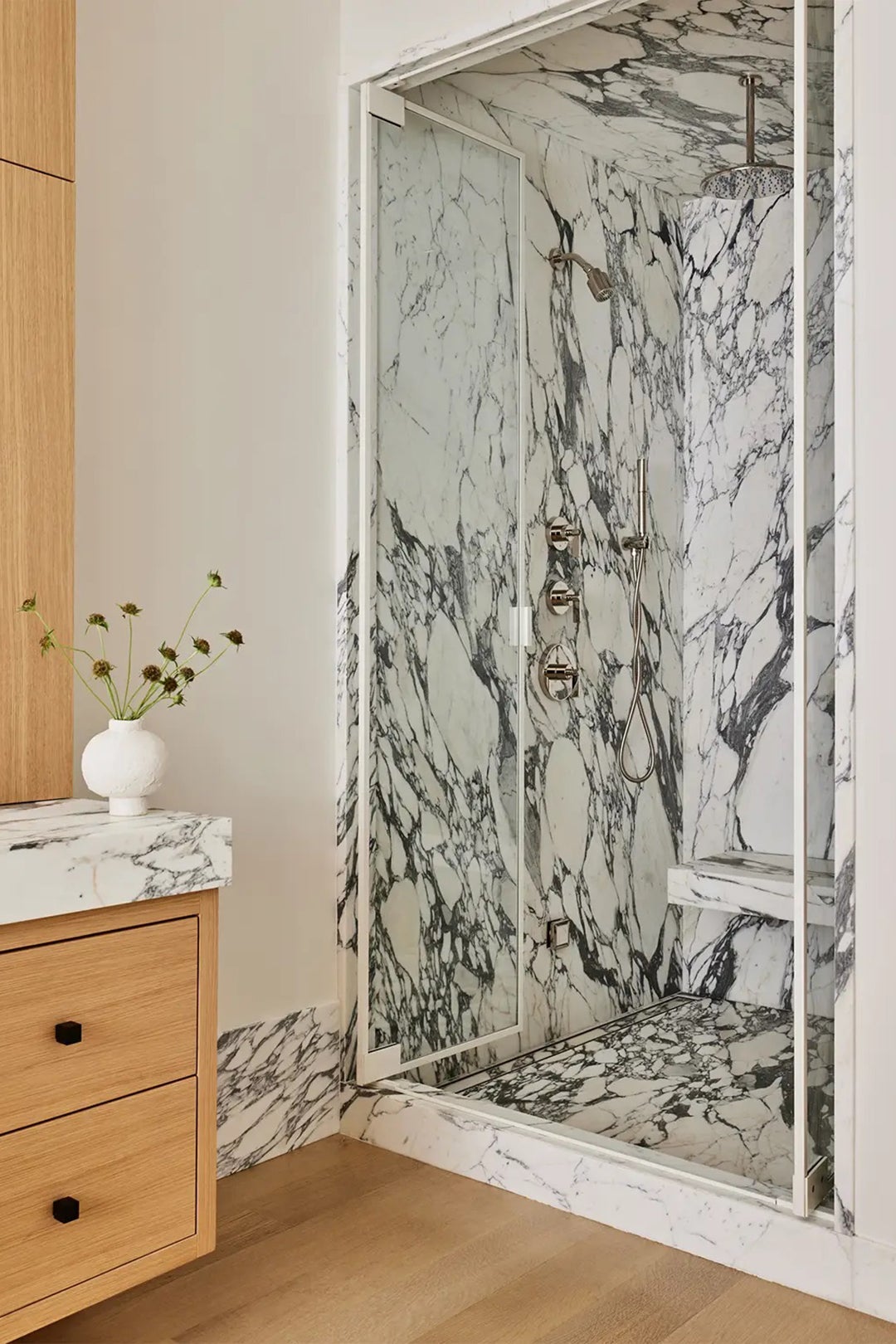This Zen Home Upgrade Is Picking Up Steam—We Asked Designers to Weigh In
We’ve spotted it in four recent home tours and counting.
Published Mar 27, 2024 3:23 PM
We may earn revenue from the products available on this page and participate in affiliate programs.
Do you beeline to your gym’s sauna or get a little too excited about the sweat-cold plunge cycle at a spa? Better yet: Is a bathroom remodel on your horizon? It’s time to consider a steam shower. We’re seeing the feature incorporated more and more in homes beyond luxury new builds—but don’t call it trendy. Steam has been used as a wellness practice for thousands of years, and perhaps we’re all just catching on now. Designers across the U.S. are bringing this perk into their practice more regularly, whether for their own houses or client projects.
“As more and more people have the flexibility to work from home and work out at home, I do anticipate a rise in popularity,” says Jennelle Butera of Hudson + Bloum Design. Read on for all the details on what it takes to put in a steam shower at home.
What Is a Steam Shower?
Simply put, a steam shower starts with a briefcase-size generator, which heats H2O from a water line until it vaporizes. The steam is then released via a steam line and steamhead in your shower wall—and voilà! Enthusiasts name-check all kinds of health benefits that steam can provide: stress relief, muscle recovery, skin hydration, and more.
When it comes to steam showers, one label reigns supreme: Mr. Steam. The 100-year-old brand is beloved by designers for its heritage, range of packages, and features like music streaming and aromatherapy. “We have used only Mr. Steam for the past 10 years,” Butera divulges. “It is great quality and our clients have never complained.”
How Much Does a Steam Shower Cost?
Martha Orellanas, vice president of marketing at Mr. Steam and a 30-year industry vet, puts the main price range of a steam shower between $2,000 and $7,000, and notes that it can go up to $10,000 with more bells and whistles (like the aforementioned aromatherapy and music). But looking in the other direction, she adds that a basic setup can come in under $2,000. It might sound like a lot, but it’s important to weigh the cost against your alternative routine. “How much money do we spend going to spas, or how much money do we spend going to a gym?” asks Orellanas.
There are more budget-friendly options out there, too. In designer Nick Poe’s experience, an expensive unit isn’t necessary to achieve steam in a small space. When he redesigned his downtown New York City apartment, he had to build the bathroom from scratch, so he installed a more affordable 6-kilowatt generator from Amazon to make his tiny tiled bathroom a respite.
How Do You Install a Steam Shower?
Short answer: It’s not a DIY. “We always ask if [clients] want a steam shower because this changes the design of the shower,” Butera says. “It needs to be planned out properly.” Orellanas echoes this sentiment, explaining that while you might be able to swap in an upgraded toilet later, you can’t do that with steam; it’s best to include it in your initial remodel plans if you think you might want it. Marissa Corvino of Corvino Designs adds that it’s smart to also mention your plan to your general contractor and electrician. In addition to the power line and the steam line, you’ll need a drain line leading away from the shower.
The generator power you choose should align with your shower sizing—Mr. Steam has a handy calculator for this. Think about it like the BTUs of an air conditioner, says Orellanas. What size space do you want to fill with steam, and how quickly do you want the process to start? The bigger the space, the more BTUs, the larger the unit. That said, there is such a thing as going too big (or high). “The ceiling height really should be 7 to 8 feet, no more,” Orellanas advises. That’s because steam rises, and if you want to enjoy the benefits, you need to contain it.
Speaking of the generator, you’ll want to install yours in an accessible nook with an electrical outlet near the shower: in a crawl space; hidden in a built-in shower bench; or concealed in millwork like a side cabinet, vanity, or closet. “We used a base cabinet in our home office, which is located adjacent to our primary shower,” Corvino says.
Installation doesn’t end there. You need to consider the steam outlet, which Orellanas says you should place 6 inches to 1 foot from the floor (you want the steam coming out as low as possible).
Then it’s about where to put the controls. If you’ve built a shower bench into your design, you want the temperature and/or feature panel at shoulder length next to where you sit so it’s easy to reach. Mr. Steam has integrations for entertainment like Spotify and even Netflix. You can use its panels to preset a time for steam to heat up or to release essential oils for aromatherapy. Corvino adds that a wireless remote add-on allows you to toggle the steam on and off and control the temperature from your phone.
Finally, any ceiling lighting within the shower needs to be wet-rated, and, to that end, ventilation is key, too. That’s because the shower glass or watertight space has to seal in the steam, and you’ll need proper flow to remove moist warm air from the room to prevent mildew, says designer Tricia Portelli of Scribe Studio.
What Should Your Steam Shower Look Like?
One of the main design considerations for steam showers is materials. Naturally, nonporous stone is the ideal choice. “Porcelain tile is probably the best tile for a steam room, because it’s really sealed and you don’t have to take care of it,” Orellanas explains. “The grout line should be very thin as well.” Butera tends to opt for ceramic and porcelain, too, over natural stone, because they hold heat better. “Natural stone tends to dissipate the steam and cools the space faster,” she says.
In its Deer Valley, Utah, project, for example, Hudson + Bloum used ceramic tile on the walls and shower lid, marble for the bench, and marble mosaic on the shower floor. “We like to use mosaics on shower floors for a nonslip surface, and more grout joints equals better grip when wet,” says Butera. Nobody recommends a fully wood interior; instead, consider teak for a bench or seat.
As for the doors, instead of one large glass partition, Corvino recommends two smaller doors that allow less steam to escape as you enter and exit. That’s the design she chose for her New Jersey brownstone bathroom. “Pivot hinges on double shower doors are a power move,” she states. They save on bathroom space, and when the doors are wet, she swings them inside the shower to dry off. Alternatively, designer Amber Lewis often favors multipane doors and glass, if that’s your thing, and she always fully encloses showers.
There are alternative ways to craft a steam shower if your preference is to not install a unit or you have space constraints. In one case, Portelli crafted a completely enclosed shower outfitted with a transom window to create the same effect.“ The choice to extend the enclosure all the way to the ceiling, coupled with the shower’s relatively compact size, facilitates the rapid generation of steam when taking a hot shower,” she explains. The operable window is key: It allows you to air out the shower as you move onto the rest of your self-care routine.







